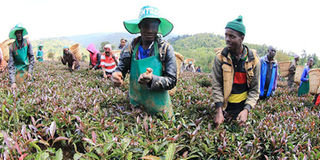Keriako Tobiko bars Nyayo Tea agency from buffer zone

Locals of Sierra Leone, Narok County, pick tea at Nyayo tea zones on July 27, 2018. PHOTO | FILE | NATION MEDIA GROUP
What you need to know:
- Natembeya accused the NTZ of extending the width of the buffer zone from 100 meters to 300 by felling indigenous trees at Olpusimoru forest.
- A dispute over the Maasai Mau Forest boundary has placed Mr Natembeya on the collision path with Rift Valley leaders.
The government has ordered the Nyayo Tea Zones Development Corporation to stop picking or cultivating of tea at the 25-kilometer buffer zone.
A government enforcement Unit stormed the offices at Siera Leon, Narok South, and ejected the workers.
"We have received orders from the Cabinet Secretary for Environment Keriako Tobiko to stop all the operations at the tea cutline, and we are enforcing that order," Narok ecosystem conservator Mwai Muraguri said on Saturday.
With the directive, the government hopes to recover thousands of hectares of land owned by prominent beneficiaries of Maasai Mau Forest Complex.
CUTLINE
When the cutline was created in 2015, the parastatal planted purple tea in a 25-kilometre area, creating a buffer zone to separate the Maasai Mau forest, under Narok County, and the Olpusimoru forest that is under the Kenya Forest Service.
Narok County Commissioner George Natembeya said: "We have reached the decision to stop the operation. The tea will be left to degenerate into bushes since the government is being accused of encroaching on the forest through planting of tea."
The buffer zone lies between Amalo River and Ewaso Ngiro, and measures 300 meters in width.
It has mostly been deemed by the settlers and politicians as the forest cutline.
The place the buffer zone is situated is where the Mau Task Force in 2009/2010 profiled 7,989 settlers who were left to dwell in the forest until the government finds a way forward.
The residents depend on the tea and forest products to earn a living.
BOUNDARY
Mr Natembeya accused the NTZ of extending the width of the buffer zone from 100 meters to 300 by felling indigenous trees at Olpusimoru forest without consent from KFS.
"The buffer zone has also stood as a barrier for wildlife migrating from Maasai Mau and Transmara forest to Olpusimoru forest, causing a big stress to the wildlife especially elephants," Mr Natembeya added.
A dispute over the Maasai Mau Forest boundary has placed Mr Natembeya on the collision path with Rift Valley leaders, who accuse him of creating a new cutline in the ongoing evictions.
While leaders such as Senate Majority Leader Kipchumba Murkomen and Kanu chairman Gideon Moi argue that the cutline should be the Nyayo Tea Zones, Mr Natembeya insists that the only legal boundary is the one established in 2009.
Deputy President William Ruto, while announcing the evictions on June 24, said that the cutline will be the tea buffer zone.
But Mr Natembeya said the tea zone cutline was only meant to separate Olpusimoru and Maasai Mau forests.





